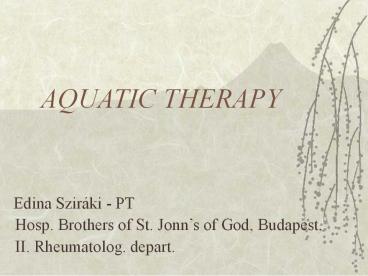AQUATIC THERAPY - PowerPoint PPT Presentation
Title:
AQUATIC THERAPY
Description:
AQUATIC THERAPY Edina Szir ki - PT Hosp. Brothers of St. Jonn s of God, Budapest, II. Rheumatolog. depart. Aquatic Therapy Halliwick and Water Specific Therapy ... – PowerPoint PPT presentation
Number of Views:1003
Avg rating:3.0/5.0
Title: AQUATIC THERAPY
1
AQUATIC THERAPY
- Edina Sziráki - PT
- Hosp. Brothers of St. Jonns of God, Budapest,
- II. Rheumatolog. depart.
2
Aquatic Therapy
- Halliwick
- and Water Specific Therapy (WST)
- The Bad Ragaz Ring Method
- Relaxation in water (Watsu, Ai Chi)
- Aerobic Conditioning
3
Aquatherapy vs. Subaquatic exercise
- According to the patient actual health and
functional status, diagnosis and needs - Specific treatment and functional goals
- Individual treatment
- Prescription
- Improve the general condition
- Usually in group
- Prescription does not neccessary
4
(No Transcript)
5
Halliwick - history
- 1949 James McMillan, new method in teaching swimm
- 1950 London, Halliwick School for Crippled Girls
- - positive effects both physicaly and
mentaly - 1952 association of Swimming Therapy
- Following the very good outcomes, water specific
therapy started, 1963 annual courses in Bad Raz - 1986 Conference Halliwick
- 1994 International Halliwick Assoc. and Found.
6
(No Transcript)
7
The Ten-Point-Programme (motor learning program)
- I. Phase getting use the water
- 1. Mental Adjusment
- - adaptation to mechanical effect
- - BREATH CONTROL (facio-oral stim.)
- - stimulate disassociated head balance
- - movement, rhytm in water, the hairs,
eyes, ears get wet
8
(No Transcript)
9
(No Transcript)
10
(No Transcript)
11
II. Phase Balance Control
- The patient must learn a centralised balance
control in every direction, during movement,
going closed kinetic chain to open chains - Sagittal rot. (lat.flex.,facilitate righting
reactions, lengthening of the trunk) - Transversal rot. (flex-ext, important for
safety!, strengthen abd, facilitate symmetry,
extension) - Longitudinal rot. (around the long. axis)
- Combined rot.(preparation for functional
movement, 3D)
12
(No Transcript)
13
(No Transcript)
14
III. Phase controlled movement
- Mental Inversion
- Balance in Stillness
- Turbulent gliding
15
(No Transcript)
16
IV. Phase movement, swimming
- Simple Progression
- with both hands, next to the body, in
fishtail or sculling actions - Basic Halliwick-movement
- arm movement, more ROM, the stroke adapted to
the patients possibilities
17
(No Transcript)
18
The Bad Ragaz Ring Method (BRRM)
- For hundreds of years the termal waters of Bad
Ragaz served only the passive form of
hydrotherapy - 1930 active hydrotherapy for peripheral lesions,
decreased range of motion - 1955 Wildbad (D) stabilization, using rings, 2D
- 1965 according Kabat, Knott, B. Davies
incorporated PNF - Developed the New Bad Ragaz Method (Egger,
McMillan) - 1990 Egger The New Bad Ragaz Method With Ring
19
BRRM
- Individual, special method of treatment
- Based on biomechanical (3D, diagonal motion,
temperature), fluidmechanics, neurophyisiology
(proprioceptive stimulation facilitates,
overflow) - Combination of relaxation, stabilization,
progressive resistance - Using flotation aids, rings which provide some
safety and help to stabilise the position - Has great results in the field of neurology,
traumatology, rehabilitation, rheumatology
20
Indication of BRRM
- Low back pain, herniated disc surg.
- Osteoarthritis
- Joint replacement
- Tendon surgery, fractures
- Muscle diseases
- Hemiplegia, para-tetraplegia
- Ataxia, dystonia, hyperkinetic syndrome
21
Goals of treatment
- Decrease pain
- Srengthening, muscle re-education
- Relaxation
- Spinal traction and elongation
- Reduction of muscular tone
- Increase of ROM
- Improve trunk stability, functional abilities,
- coordinations, aerob capacity
22
BRRM compared to PNF
- BRRM has no strech reflex, less different
technics - Resistance provided by hydromechanics and
therapist - Movement not only the distal, but the proximal
parts
23
Application of BRRM
- The therapist immersed max.to T9, and is the fix
point - The patient is supine
- The treatment time is 10-15 min, later on 30 min
- The amount of resistance can controlled by the
speed of the movement - Progression of exercise ROM, lever arm,
amplitude, different directions, shape,
equipments
24
Relaxation in water
- Watsu
- Jahara
- Waterdance
- Floating
- Aquamouvance(CAN)
- Aquasage(NL)
- Ai Chi
- Halliwick
25
Relaxation decrease tension
- Physical tension
- Cope with mental tension
- Influence the autonomous system
- Treat functional problems with relaxation
- - moving consiously
- - stretching
26
Watsu
- Zen - shiatsu (Harold Dull)
- Shiatsu-massage
- Stretching the meridians
- Being together
- Goal not to have goals
27
Ai Chi
- Combination of deep breathing and slow broad
movements - Originated by Jun Kunno, Yokohama
- Water depth at shoulder level, temp. 30-35º
- Work to the point of tension, without pain
- Benefits ROM, relax, breath and mental effects
28
Summary
- The main therapeutic goal of the specific
treatments is improving and maintan the function.
- For that reason, they are concentrate on head
and trunk control, equillibrum, stability,
muscle balance, range of motion and decrease the
pain.
29
(No Transcript)































